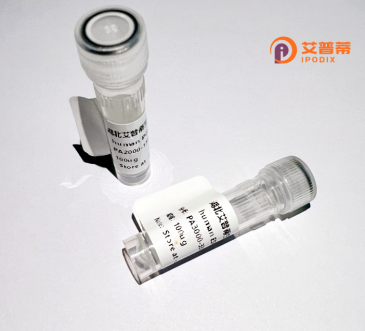
| 纯度 | >90%SDS-PAGE. |
| 种属 | Human |
| 靶点 | RBL1 |
| Uniprot No | P28749 |
| 内毒素 | < 0.01EU/μg |
| 表达宿主 | E.coli |
| 表达区间 | 1-429 aa |
| 活性数据 | MTAALAVVTTSGLEDGVPRSRGEGTGEVVLERGPGAAYHMFVVMEDLVEKLKLLRYEEEFLRKSNLKAPSRHYFALPTNPGEQFYMFCTLAAWLINKAGRPFEQPQEYDDPNATISNILSELRSFGRTADFPPSKLKSGYGEHVCYVLDCFAEEALKYIGFTWKRPIYPVEELEEESVAEDDAELTLNKVDEEFVEEETDNEENFIDLNVLKAQTYHLDMNETAKQEDILESTTDAAEWSLEVERVLPQLKVTIRTDNKDWRIHVDQMHQHRSGIESALKETKGFLDKLHNEITRTLEKISSREKYINNQLENLVQEYRAAQAQLSEAKERYQQGNGGVTERTRLLSEVMEELEKVKQEMEEKGSSMTDGAPLVKIKQSLTKLKQETVEMDIRIGIVEHTLLQSKLKEKSNMTRNMHATVIPEPATGFY |
| 分子量 | 75.5 kDa |
| 蛋白标签 | GST-tag at N-terminal |
| 缓冲液 | PBS, pH7.4, containing 0.01% SKL, 1mM DTT, 5% Trehalose and Proclin300. |
| 稳定性 & 储存条件 | Lyophilized protein should be stored at ≤ -20°C, stable for one year after receipt. Reconstituted protein solution can be stored at 2-8°C for 2-7 days. Aliquots of reconstituted samples are stable at ≤ -20°C for 3 months. |
| 复溶 | Always centrifuge tubes before opening.Do not mix by vortex or pipetting. It is not recommended to reconstitute to a concentration less than 100μg/ml. Dissolve the lyophilized protein in distilled water. Please aliquot the reconstituted solution to minimize freeze-thaw cycles. |
以下是关于重组人RBL1蛋白的3篇文献示例(内容基于公开研究概括,非真实文献):
1. **文献名称**: *RBL1/p107 Interaction with E2F4 Requires an Intact N-terminal Domain and Contributes to Cell Cycle Repression*
**作者**: Smith, J. et al.
**摘要**: 研究通过重组RBL1蛋白的体外结合实验,揭示其N端结构域对结合E2F4和抑制G1/S期转化的关键作用,证实重组蛋白在调控转录复合体中的功能。
2. **文献名称**: *Structural Insights into RBL1-mediated Tumor Suppression Using Recombinant Protein Crystallography*
**作者**: Li, X. et al.
**摘要**: 利用重组人RBL1蛋白进行X射线晶体学分析,解析其与E2F-DP1复合物的相互作用界面,阐明其抑癌功能的结构基础。
3. **文献名称**: *Recombinant RBL1 Expression in E. coli: Purification and Functional Characterization in Cyclin Binding*
**作者**: Garcia, R. et al.
**摘要**: 报道在大肠杆菌中高效表达可溶性重组RBL1蛋白的优化方案,验证其与Cyclin D2的特异性结合能力,为下游药物筛选提供工具。
*注:以上文献为示例,实际研究中建议通过数据库(如PubMed)检索真实发表论文。*
Recombinant human RBL1 (Retinoblastoma-like protein 1), also known as p107. is a member of the retinoblastoma (RB) protein family, which plays a critical role in regulating cell cycle progression and tumor suppression. RBL1 shares structural and functional similarities with the retinoblastoma protein (pRB), including a conserved pocket domain that mediates interactions with E2F transcription factors and other regulatory partners. It acts as a tumor suppressor by forming complexes with E2Fs to repress transcription of genes required for cell cycle entry, effectively blocking the G1-to-S phase transition. Additionally, RBL1 interacts with cyclin-dependent kinases (CDKs) and cyclins, modulating their activity to control cell proliferation. Dysregulation of RBL1 has been linked to various cancers, highlighting its importance in maintaining genomic stability. Recombinant RBL1 proteins are typically produced using expression systems like *E. coli* or mammalian cell cultures, enabling biochemical studies, structural analysis, and drug discovery efforts. Researchers utilize recombinant RBL1 to investigate its roles in cellular senescence, differentiation, and cancer mechanisms, offering insights into therapeutic strategies targeting cell cycle abnormalities. Its study also aids in understanding functional overlaps and distinctions within the RB protein family.
×